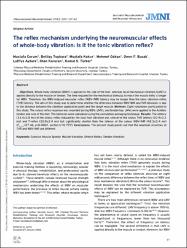| dc.contributor.author | Çorum, Mustafa | |
| dc.contributor.author | Topkara, Betilay | |
| dc.contributor.author | Kökçe, Mustafa | |
| dc.contributor.author | Özkan, Mehmet | |
| dc.contributor.author | Bucak, Ömer Faruk | |
| dc.contributor.author | Aytüre, Lütfiye | |
| dc.contributor.author | Karacan, İlhan | |
| dc.contributor.author | Türker, Kemal Sıtkı | |
| dc.date.accessioned | 2023-10-11T18:18:37Z | |
| dc.date.available | 2023-10-11T18:18:37Z | |
| dc.date.issued | 2022 | en_US |
| dc.identifier.issn | 1108-7161 | |
| dc.identifier.uri | https://hdl.handle.net/11363/5840 | |
| dc.description.abstract | Objectives: Whole-body vibration (WBV) is applied to the sole of the foot, whereas local mechanical vibration (LMV) is
applied directly to the muscle or tendon. The time required for the mechanical stimulus to reach the muscle belly is longer
for WBV. Therefore, the WBV-induced muscular reflex (WBV-IMR) latency may be longer than the tonic vibration reflex
(TVR) latency. The aim of this study was to determine whether the difference between WBV-IMR and TVR latencies is due
to the distance between the vibration application point and the target muscle. Methods: Eight volunteers participated in
this study. The soleus reflex response was recorded during WBV, LMVs, and tendon tap. LMVs were applied to the Achilles
tendon and sole of the foot. The latencies were calculated using the cumulative averaging technique. Results: The latency
(33.4±2.8 ms) of the soleus reflex induced by the local foot vibration was similar to the soleus TVR latency (30.9±3.2
ms) and T-reflex (32.0±2.4 ms) but significantly shorter than the latency of the soleus WBV-IMR (42.3±3.4 ms)
(F(3,21)=27.46, p=0.0001, partial η2=0.797). Conclusions: The present study points out that the neuronal circuitries of
TVR and WBV-IMR are different. | en_US |
| dc.language.iso | eng | en_US |
| dc.publisher | JMNI, 7 SPILIADOU SQ, NAFPLION 21 100, GREECE | en_US |
| dc.rights | info:eu-repo/semantics/openAccess | en_US |
| dc.rights | Attribution-NonCommercial-NoDerivs 3.0 United States | * |
| dc.rights.uri | http://creativecommons.org/licenses/by-nc-nd/3.0/us/ | * |
| dc.subject | Exercise | en_US |
| dc.subject | Muscle Spindle | en_US |
| dc.subject | Muscle Vibration | en_US |
| dc.subject | Stretch Reflex | en_US |
| dc.subject | Tendon Vibration | en_US |
| dc.title | The reflex mechanism underlying the neuromuscular effects of whole-body vibration: Is it the tonic vibration reflex? | en_US |
| dc.type | article | en_US |
| dc.relation.ispartof | Journal of Musculoskeletal and Neuronal Interactions | en_US |
| dc.department | Diş Hekimliği Fakültesi | en_US |
| dc.authorid | https://orcid.org/0000-0002-7462-1358 | en_US |
| dc.identifier.volume | 22 | en_US |
| dc.identifier.issue | 1 | en_US |
| dc.identifier.startpage | 37 | en_US |
| dc.identifier.endpage | 42 | en_US |
| dc.relation.publicationcategory | Makale - Uluslararası Hakemli Dergi - Kurum Öğretim Elemanı | en_US |
| dc.contributor.institutionauthor | Topkara, Betilay | |
| dc.contributor.institutionauthor | Türker, Kemal Sıtkı | |



















